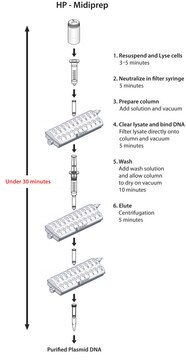G1N10
GenElute™ Mammalian Genomic DNA Miniprep Kits
sufficient for 10 purifications
Sinónimos:
Mammalian Genomic DNA Miniprep, Gen Elute
About This Item
Productos recomendados
uso
sufficient for 10 purifications
temp. de almacenamiento
15-25°C
¿Está buscando productos similares? Visita Guía de comparación de productos
Descripción general
The starting materials are lysed in a chaotropic salt-containing solution to ensure the thorough denaturation of macromolecules. The addition of ethanol causes DNA to bind when the lysate is spun through a silica membrane in a microcentrifuge tube. After washing to remove the contaminants, the DNA is eluted in 200 μL of a Tris-EDTA solution. The expected yields of genomic DNA will vary depending on the amount and type of starting material used. DNA purified with the kit has an A260/A280 ratio between 1.6 and 1.9 and can be up to 50 kb in length.
The purified genomic DNA is ready for immediate use in downstream applications such as restriction digest, PCR, southern blots, and sequencing reactions.
Aplicación
- restriction endonuclease digestions
- PCR
- Southern blots
- sequencing reactions
- cloning
- ligation
Características y beneficios
- Expected yield: 25 μg from 2 x 106 cultured cells; 30 μg from 25 mg of tissue
- Elution volume: 200 - 400 μl
- Time required: 20 min after lysis
- A260/A280 ratio: 1.6 - 1.9
- Mechanical homogenization required: No
Principio
Otras notas
Información legal
Opcional
Producto relacionado
Palabra de señalización
Danger
Frases de peligro
Consejos de prudencia
Clasificaciones de peligro
Acute Tox. 4 Oral - Aquatic Acute 1 - Aquatic Chronic 2 - Eye Dam. 1 - Met. Corr. 1 - Resp. Sens. 1 - Skin Irrit. 2 - STOT SE 3
Órganos de actuación
Respiratory system
Código de clase de almacenamiento
8A - Combustible corrosive hazardous materials
Punto de inflamabilidad (°F)
483.8 °F
Punto de inflamabilidad (°C)
251 °C
Elija entre una de las versiones más recientes:
¿Ya tiene este producto?
Encuentre la documentación para los productos que ha comprado recientemente en la Biblioteca de documentos.
Los clientes también vieron
Artículos
The availability of simple methods for purification of DNA and RNA has greatly facilitated the analysis and characterization of the genome and gene expression. There is a demand to isolate DNA and RNA rapidly and conveniently from a variety of cellular sources, including cells and tissues from mammalian, plant and bacterial cultures.
Protocolos
Archived Formalin-fixed, Paraffin-embedded (FFPE) tissue samples are invaluable resources for profiling gene expression and studying a variety of diseases.
This protocol provides a simple and convenient method to isolate, amplify, and purify genomic DNA from buccal swabs. Buccal swabs are a convenient method of acquiring a DNA sample.
The GenElute Mammalian Genomic DNA Purification Kit Protocol describes the isolation of pure, high molecular weight DNA from a variety of mammalian sources.
An introduction to both Northern and Southern blotting, popular methods for the transfer of macromolecules to membranous support. This article also offers a Southern blot protocol and a northern blot protocol.
Contenido relacionado
Nuestro equipo de científicos tiene experiencia en todas las áreas de investigación: Ciencias de la vida, Ciencia de los materiales, Síntesis química, Cromatografía, Analítica y muchas otras.
Póngase en contacto con el Servicio técnico












